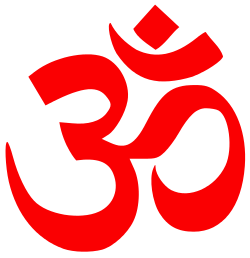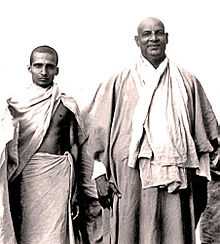Sivananda Saraswati
| Sivananda Saraswati | |
|---|---|
|
Krishnananda and Sivananda (right), circa 1945 | |
| Born |
Kuppuswami 8 September 1887 Pattamadai, Tamil Nadu, India |
| Died |
14 July 1963 (aged 75) Rishikesh, Uttarakhand, India |
| Nationality | Indian |
| Founder of | Divine Life Society |
| Guru | Vishwānanda Saraswati |
| Philosophy | Yoga of Synthesis |
| Prominent Disciple(s) | Chinmayananda Saraswati, Satchidananda Saraswati, Vishnudevananda Saraswati, Sivananda Radha Saraswati, Satyananda Saraswati, Jyotirmayananda Saraswati |
| Quotation | Be Good, do Good. |
Sivananda Saraswati (8 September 1887 – 14 July 1963) was a Hindu spiritual teacher and a proponent of Yoga and Vedanta. Sivananda was born Kuppuswami in Pattamadai, in the Tirunelveli district of Tamil Nadu. He studied medicine and served in British Malaya as a physician for several years before taking up monasticism. He lived most part of his life near Muni Ki Reti, Rishikesh.
He was the founder of the Divine Life Society (DLS) in 1936, Yoga-Vedanta Forest Academy (1948) and author of over 200 books on yoga, Vedanta and a variety of subjects. He established Sivananda Ashram, the headquarters of the DLS, on the bank of the Ganges at Sivanandanagar, 3 kilometres (1.9 mi) from Rishikesh.[1][2][3]
Sivananda Yoga, the yoga form propagated by his disciple Vishnudevananda, is now spread in many parts of the world through Sivananda Yoga Vedanta Centres. These centres are not affiliated with Sivananda's ashrams, which are run by the Divine Life Society.
Early life
| Part of a series on | ||||||||||||||||||||||||||
| Hindu philosophy | ||||||||||||||||||||||||||
|---|---|---|---|---|---|---|---|---|---|---|---|---|---|---|---|---|---|---|---|---|---|---|---|---|---|---|
 | ||||||||||||||||||||||||||
| Āstika | ||||||||||||||||||||||||||
|
|
||||||||||||||||||||||||||
| Nāstika | ||||||||||||||||||||||||||
|
Other schools |
||||||||||||||||||||||||||
| People | ||||||||||||||||||||||||||
|
||||||||||||||||||||||||||
|
Poet-Saints
|
||||||||||||||||||||||||||
Sivananda was born Kuppuswamy in Pattamadai near Tirunelveli in Tamil Nadu, India, as the third son to his parents on 8 September 1887. As a child he was very active and promising in academics and gymnastics. He attended medical school in Tanjore, where he excelled. He ran a medical journal called Ambrosia during this period. Upon graduation he practised medicine and worked as a doctor in Malaya for ten years, with a reputation for providing free treatment to poor patients. Over time, a sense that medicine was healing on a superficial level grew in him, urging him to look elsewhere to fill the void, and in 1923 he left Malaya and returned to India to pursue a spiritual quest.
Initiation
Upon his return to India in 1924, he visited Varanasi, Nashik, and then Rishikesh, where he met his guru, Vishwānanda Saraswati. It was Vishwānanda who initiated him into the Sannyasa order, and gave him his monastic name. However, since Sivānanda spent only a few hours with Vishwānanda, the full Viraja Homa ceremonies were performed later by Vishnudevānanda, the Mandaleswara of Sri Kailas Ashram. After initiation, Sivananda settled in Rishikesh, and immersed himself in intense spiritual practices. Sivānanda performed austerities for many years but he also continued to nurse the sick. With some money from his insurance policy that had matured, he started a charitable dispensary at Lakshman Jhula in 1927, serving pilgrims, holy men and the poor using his medical expertise.
Travels

After a few years, Sivananda went on an extensive pilgrimage and travelled the length and breadth of India to meditate at holy shrines and came in contact with spiritual teachers throughout India. During this Parivrajaka (wandering monk) life, Sivānanda visited important places of pilgrimage in the south, including Rameshvaram. He conducted Sankirtan and delivered lectures during his travels. He visited the Sri Aurobindo Ashram, and met Maharishi Shuddhananda Bharati to which he gave the title of Maharishi. At the Ramana Ashram, he had the darshan of Ramana Maharshi on Maharshi's birthday. He sang bhajans and danced in ecstasy with Maharshi's bhaktas. He also went on pilgrimages to various places in northern India including Kedarnath and Badrinath. He visited Kailash-Manasarovar in 1931.
Foundations

During Sivananda's stay in Rishikesh and his travels around India, many came to him for guidance in the spiritual path. He permitted some of them to live near him and instructed them. Sivananda asked his students take copies of his short articles and send them for publication. Over time, large numbers of people started coming to him and his devotees started growing in numbers.
Sivananda founded the DLS in 1936 on the banks of the Ganges River. The free distribution of spiritual literature drew a steady flow of disciples to him, such as Satyananda Saraswati, founder of Satyananda Yoga.
In 1945, Sivananda created the Sivananda Ayurvedic Pharmacy, and organised the All-world Religions Federation. He established the All-world Sadhus Federation in 1947 and Yoga-Vedanta Forest Academy in 1948. He called his yoga the Yoga of Synthesis.
Disciples

Sivananda's two chief acting organizational disciples were Chidananda Saraswati and Krishnananda Saraswati. Chidananda Saraswati was appointed president of the DLS by Sivananda in 1963 and served in this capacity until his death in 2008. Krishnananda Saraswati was appointed General Secretary by Sivananda in 1958 and served in this capacity until his death in 2001.
Other prominent disciples were Venkatesananda Saraswati (South Africa, Mauritius, Madagascar, Australia), Pranavanda Saraswati (Malaysia) and Sivananda Radha Saraswati (Canada). Another prominent disciple was Swami Sahajananda Saraswati (South Africa), who was directed by Sivananda to establish the Divine Life Society of South Africa.
- Disciples who went on to grow new organisations
- Chinmayananda Saraswati, founder of the Chinmaya Mission
- Jyotirmayananda Saraswati, President of the Yoga Research Foundation, Miami, USA
- Lalitānanda Saraswati, Vice-President of the Yoga Research Foundation
- Omkarananda Saraswati, founder of Omkarananda Ashram, Himalayas
- Satchidananda Saraswati, founder of the Integral Yoga Institutes, Around the world
- Satyananda Saraswati, founder of Bihar School of Yoga
- Shantananda Saraswati, founder of Temple of Fine Arts (Malaysia & Singapore)
- Sivananda Radha Saraswati, founder of Yasodhara Ashram, British Columbia, Canada
- Vishnudevananda Saraswati, founder of the Sivananda Yoga Vedanta Centres, HQ Canada
- Venkatesananda Saraswati, inspirer of Ananda Kutir Ashrama in South Africa
- Sahajananda Saraswati, Spiritual Head of Divine Life Society of South Africa
- Vedula Satyananda Rao, founder of High-Tech Yoga Institute, Massachusetts, USA
Authorship
A prolific author, Sivananda wrote 296 books on a variety of subjects: metaphysics, yoga, religion, western philosophy, psychology, eschatology, fine arts, ethics, education, health, sayings, poems, epistles, autobiography, biography, stories, dramas, messages, lectures, dialogues, essays and anthology. His books emphasised the practical application of Yoga philosophy over theoretical knowledge.
Death
Sivananda died (attained Maha Samadhi) on 14 July 1963 in his Kutir on the bank of the Ganges, in Sivanandanagar.
Bibliography
- Sivananda (Swami.)(1944) YOGIC HOME EXERCISES. Easy Course of Physical Culture for Men & Women, Bombay,Taraporevala Sons & Co
- Sivananda (Swami.) (1946). Siva-Gita: an epistolary autobiography. The Sivananda Publication League. Retrieved 13 April 2011.
- Sivananda (Swami.) (1950). Principal Upanishads: with text, meaning notes and commentary. Yoga Vedanta Forest University, Divine Life Society. Retrieved 13 April 2011.
- Sivananda (Swami.); Patañjali (1950). Raja Yoga: theory and practice. Yoga Vedanta Forest University, Divine Life Society. Retrieved 13 April 2011.
- Sivananda (Swami) (1953). Inspiring songs and kirtans. Yoga-Vedanta Forest University. Retrieved 13 April 2011.
- Sivananda (Swami) (1956). Music as yoga. The Yoga-Vedanta Forest University for the Sivananda Mahasamsthanam. Retrieved 13 April 2011.
- Sivananda (Swami) (1956). Yoga of synthesis. Yoga-Vedanta Forest University. Retrieved 13 April 2011.
- Sivananda (Swami) (1957). Story of my tour. Yoga-Vedanta Forest University. Retrieved 13 April 2011.
- Sivananda (Swami.); Sivananda-Kumudini Devi (1960). Sivananda's letters ro Sivananda-Kumudini Devi. Yoga-Vedanta Forest Academy. Retrieved 13 April 2011.
- Sivananda (Swami); India (1962). Lord Siva and his worship. Yoga-Vedanta forest academy, Divine life Society. Retrieved 13 April 2011.
- Sivananda (Swami.) (1966). Yoga practice, for developing and increasing physical, mental and spiritual powers. D.B. Taraporevala Sons. Retrieved 13 April 2011.
- Sivananda (Swami) (1970). Fourteen lessons in raja yoga. Divine Life Society. Retrieved 13 April 2011.
- Sivananda (Swami) (1970). Inspiring songs and sayings. The Divine Life Society. Retrieved 13 April 2011.
- Sivananda (Swami) (1970). Yoga Vedanta dictionary. Yoga Vedanta Forest Academy. Retrieved 13 April 2011.
- Sivananda (Swami.) (1971). Kundalini yoga. Divine Life Society. Retrieved 13 April 2011.
- Sivananda (Swami.) (1971). The science of pranayama. Divine Life Society. Retrieved 13 April 2011.
- Sivananda (Swami) (1973). Ten upanishads: with notes and commentary 8th ed. Divine Life Society. Retrieved 13 April 2011.
- Sivananda (Swami) (1978). Sivananda vani: the cream of Sri Swami Sivananda's immortal, practical instructions on the yoga of synthesis in his own handwriting. Divine Life Society. Retrieved 13 April 2011.
- Swami Sivananda (1979). Practice of yoga. The Divine Life Society. Retrieved 13 April 2011.
- Sivananda (Swami.) (1980). Autobiography of Swami Sivananda. Divine Life Society. Retrieved 13 April 2011.
- Sivananda (Swami.) (1981). Japa Yoga: a comprehensive treatise on mantra-sastra. Divine Life Society. Retrieved 13 April 2011.
- Sivananda (Swami) (1981). Science of Yoga: Raja yoga ; Jnana yoga ; Concentration and meditation. Divine Life Society. Retrieved 13 April 2011.
- Sivananda (Swami.) (1982). Moksha gita. Divine Life Society. Retrieved 13 April 2011.
- Sivananda (Swami.) (1983). Samadhi yoga. The Divine Life Society. Retrieved 13 April 2011.
- Sivananda (Swami) (1984). Yoga samhita. Divine Life Society. Retrieved 13 April 2011.
- Sivananda (1985). The Brihadaranyaka Upanishad: Sanskrit text, English translation, and commentary. Divine Life Society. Retrieved 13 April 2011.
- Sivananda (Swami.) (1985). Karma yoga. Divine Life Society. ISBN 978-0-949027-05-4. Retrieved 13 April 2011.
- Sivananda (Swami) (1 January 1987). Bhakti yoga. Divine Life Society, Fremantle Branch. ISBN 978-0-949027-08-5. Retrieved 13 April 2011.
- Sivananda (Swami) (1996). Lord Shanmukha and his worship. Divine Life Society. ISBN 978-81-7052-115-0. Retrieved 13 April 2011.
- Swami Sivananda (December 2005). Raja Yoga. Kessinger Publishing. ISBN 978-1-4253-5982-9. Retrieved 13 April 2011.
Further reading
- Sivananda and the Divine Life Society: A Paradigm of the "secularism," "puritanism" and "cultural Dissimulation" of a Neo-Hindu Religious Society, by Robert John Fornaro. Published by Syracuse University, 1969.
- From Man to God-man: the inspiring life-story of Swami Sivananda, by N. Ananthanarayanan. Published by Indian Publ. Trading Corp., 1970.
- Swami Sivananda and the Divine Life Society: An Illustration of Revitalization Movement, by Satish Chandra Gyan. Published by s.n, 1979.
- Life and Works of Swami Sivananda, by Sivānanda, Divine Life Society (W.A.). Fremantle Branch. Published by Divine Life Society, Fremantle Branch, 1985. ISBN 0-949027-04-9.
- Sivananda: Biography of a Modern Sage, by Swami Venkatesānanda. Published by Divine Life Society, 1985. ISBN 0-949027-01-4. Online
References
- ↑ Divine Life Society Britannica.com
- ↑ Divine Life Society Divine enterprise: Gurus and the Hindu Nationalist Movement, by Lise McKean. University of Chicago Press, 1996. ISBN 0-226-56009-0. Page 164=165.
- ↑ Swami Shivananda Religion and anthropology: a critical introduction, by Brian Morris. Cambridge University Press, 2006. ISBN 0-521-85241-2. Page 144.
External links
| Wikimedia Commons has media related to Sivananda Saraswati. |
| Wikiversity has learning materials about Buddha oracle#33 Plan of the Day (Swami Sivananda) |
- Divine Life Society
- Swami Sivananda at DMOZ
- Dedication to Swami Sivananda
- Downloadable Books by Swami Sivananda, Divine Life Society
| ||||||||||||||
|
